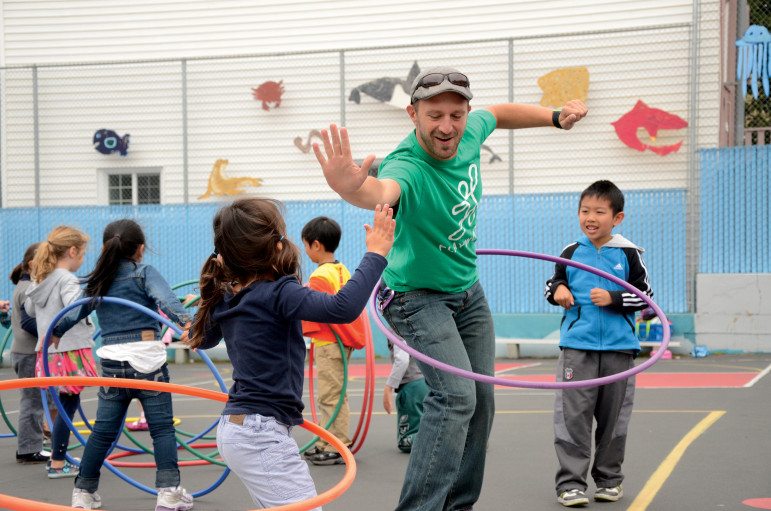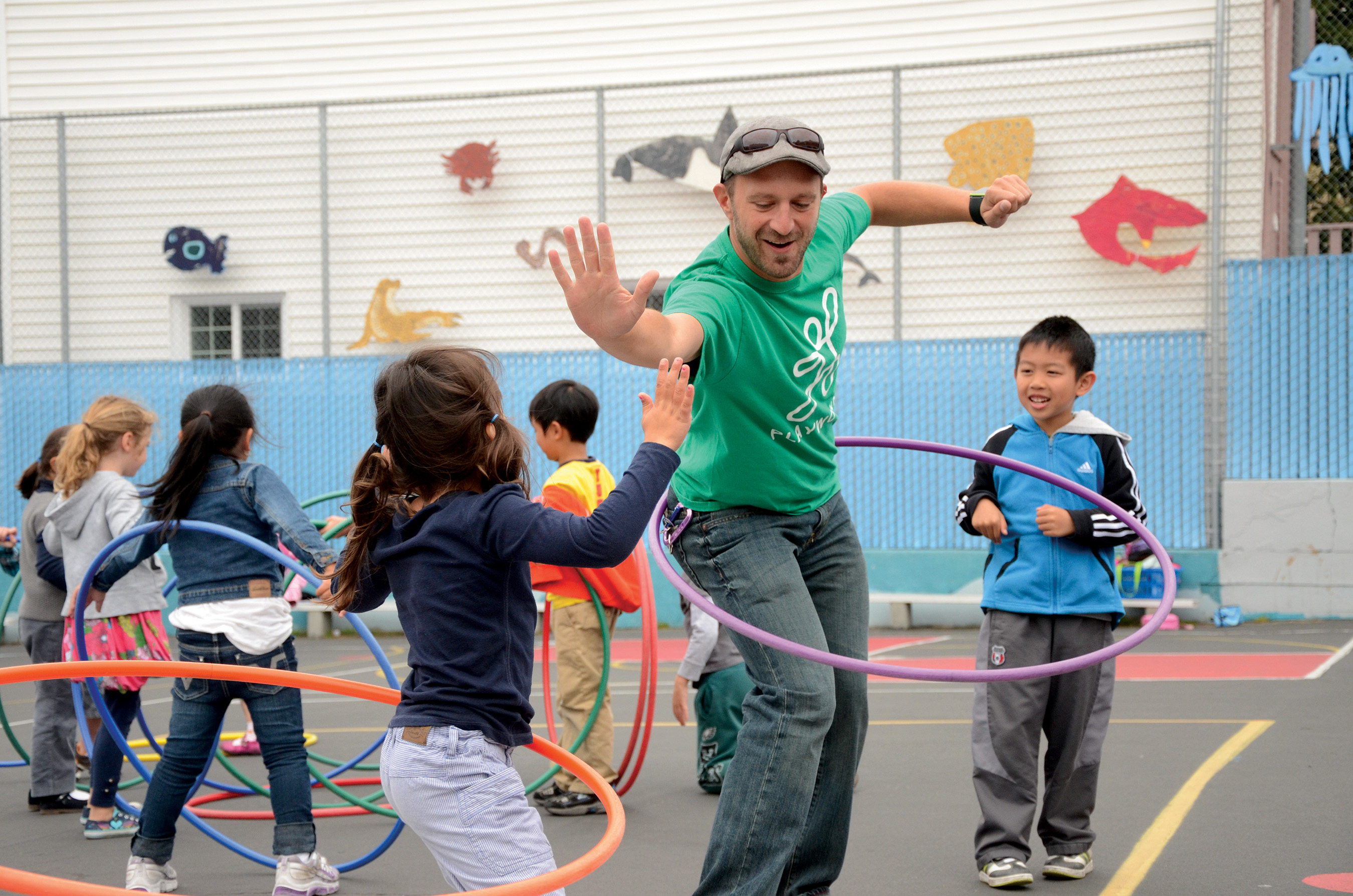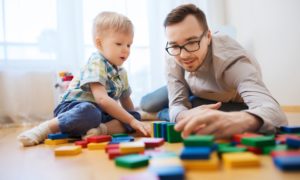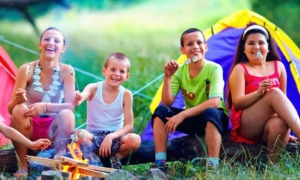
Photo courtesy of Playworks
Children spend much less time in unstructured play than they used to, according to historians of play, and many schools no longer offer recess. The nonprofit Playworks, founded in Oakland, Calif., hopes to change that by managing recess for schools and by offering playground coaches to youth organizations.
Cynthia Gentry, founder of the Atlanta Task Force on Play, remembers the summers of her childhood: She’d leave home in the morning and spend all day playing with neighborhood kids.
“You’d ride your bike and build forts,” she said.
She’d have lunch at someone else’s house, where the kids might stage a play or carnival in the backyard. Mothers were around, but were not involved in their play.
Gentry, who grew up in the 1950s and ’60s in a middle-class Atlanta neighborhood, recalls those summers as an idyllic time.
“We were so fortunate,” she said. “[The opportunity for play] was just so wide open.”
Today, Gentry, a board member of the International Play Association, doesn’t see kids wandering around the neighborhood — and she would worry if she did.
Children’s play has changed, she said. Historians of play agree.
Diane Levin, a professor of early-childhood education at Wheelock College in Boston, teaches a class about play. For the past decade, she’s had her undergraduate students interview people older than 50 about their childhood play experiences — who regularly reported playing outside much of the time. They generally played with other children and, they said, adults were not involved.
“The older ones taught the younger ones,” Levin said, perpetuating a culture of play.
Today, she explained, kids spend less time in active play, and the quality of their play has decreased.
“Children spend much less time playing and more time with screens at earlier and earlier ages,” she said.
The loss of free play
Children ages 8 to 10 spend nearly eight hours per day using electronic media, according to the American Academy of Pediatrics in a 2013 report. Older children and teens spend more than 11 hours per day, the report noted.
“Since the 1970s, children have lost about 12 hours per week in free time, including a 25 percent decrease in play and a 50 percent decrease in unstructured outdoor activities,” according to a study at Yeshiva University and published in the journal Pediatrics in 2009.
The changes are real, said Stuart Brown, founder of the National Institute for Play. “Over-organization has increased.”
[module type=”aside” align=”right”]6 times more likely.
The likelihood a child in the U.S. will play a video game rather than ride a bike.
SOURCE: Kaiser Family Foundation and the CDC
[/module]In middle-income families, play has become an organized, scheduled, structured activity. It’s not only that parents are working, and it’s not only that they feel an urgency to help their kids compete academically and socially.
Levin said parents also turn to organized activities to get their children away from screens.
While low-income parents may not over-organize their children, those kids may lack playgrounds or safe places to play outdoors, Gentry said.
Also, there is an increased perception of danger in letting kids roam, Brown said, though he asserts that danger is not any greater than it was in prior decades. Outside of some high-crime areas, the majority of areas are safer than they were 20 to 30 years ago, Brown said.
Of note, in November, the FBI reported that violent crime had dropped 4.4 percent in the United States since 2013, continuing a decades long drop to the lowest level since the 1970s.
Many other researchers bemoan the loss of play for young people. Peter Gray, a research professor of psychology at Boston College, writes in the Journal of Play (2011) about how children’s free play has declined in the United States during the past 50 years.
Joe L. Frost, a professor emeritus at the University of Texas at Austin who has spent his career researching play and playgrounds, said that high-stakes testing in schools is “inflicting more developmental damage to free, spontaneous play” than any organized program.
“All these things — adult anxiety, organized sports, tech-play and high-stakes testing — collectively and independently reduce children’s opportunities for creative, absorbing play in natural contexts,” he said in an American Journal of Play interview.
In addition, changes in the way towns and neighborhoods are constructed has had a major impact, Gentry noted.
“We are no longer designing an environment that is welcome” to kids, she said. “Everything is car-based.”
Since the 1940s, urban development designed around cars has created neighborhoods with traffic but often without sidewalks and safe places to ride bikes, according to a report “Does the built environment influence physical activity?” by the Transportation Research Board of the Institute of Medicine of the National Academies.
Frost asserts the decline in spontaneous play harms children’s health and development. Research shows that such play enables them to better adapt to the world.
“They become more flexible in their thinking, and they develop creative and aesthetic appreciation,” he said.
Free play makes kids more resilient and helps them manage stress, according to the American Academy of Pediatrics. It also helps them develop socially, emotionally and cognitively.
Multiple benefits of play
Levin said quality play allows children to build new activities into the play. For example, a small child with building blocks experiments to see how high she can build a tower. She figures out how to build a bridge or create some other new structure.
Children come up with their own “problems” to solve, Levin said, and they figure out solutions.
Levin said children need a return to more active, spontaneous play in the summertime — and he does does not see the urgency behind efforts to stem summer learning loss.
[module type=”aside” align=”right”]Aspen Institute’s suggestions for creating more unstructured play
- After-school programs can set aside time for casual play. A large group of kids, for example, can be divided into small-sided soccer games.
- Parks and recreation departments can carve out time at fields and gyms for pick-up games. Provide equipment and loose supervision.
- Schools can commit to providing recess.
- Businesses can connect urban kids with outdoor activities. They can provide incentives for employees to volunteer with youth organizations and supervise activities.
- Parents can create safe places to play and organize playdates.
Source: “Sport for All, Play for Life,” Aspen Institute
[/module]
“There’s this big push for academics. It harms play,” she said.
Summer programs that involve rote learning are anathema to her. What’s needed, she said, are programs that provide active play and encourage children to explore and figure things out — not just follow the rules and get with the program.
For older kids, Levin prefers community-based activities that let them contribute in some way and see the effect.
“Doing more academics in the summer is not what I would advocate,” she said.
“The more we can involve [young people] in active learning, the more ‘whole’ they will become,” she said.
Gentry is also concerned.
“Kids don’t know how to explore anymore. They don’t go outside. They don’t know how to make stuff,” she said.
She sees hope, however, in a resurgence of interesting playgrounds.
And while schools have cut recess time, a group called Playworks is expanding to manage recess for schools.
Founded by Jill Vialet in Oakland, Calif., in 1996, Playworks is based on the idea that because children have had less unstructured play, they’ve lost some understanding of how to manage their own play. Playworks transforms chaotic recess periods by offering structured games as well as the opportunity for free play. It teaches conflict resolution and also engages kids in teaching other kids. It also organizes play for after-school organizations.
And Frost sees hope in a number of trends. More groups are questioning the value of widespread standardized testing, he said. He also sees a growing interest in the outdoors in groups like the Children & Nature Network.
“We can’t go home again to the times when virtually every child worked and played in the natural playgrounds of creeks and hills, mudholes, junkyards, overgrown lots, and fields and barnyards, but we can show the world how to bring little pieces of such rich, nurturing places to our schoolyards, neighborhoods and cities,” he said.
See sidebar “Vital Ingredient Missing in Children’s Lives: Nature”
































